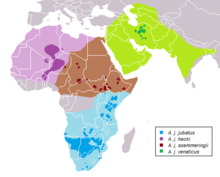Northwest African cheetah
| Northwest African cheetah | |
|---|---|
 |
|
| A Northwest African cheetah at Termit Massif, Niger. | |
| Scientific classification | |
| Kingdom: | Animalia |
| Phylum: | Chordata |
| Class: | Mammalia |
| Order: | Carnivora |
| Family: | Felidae |
| Genus: | Acinonyx |
| Species: | A. jubatus |
| Subspecies: | A. j. hecki |
| Trinomial name | |
|
Acinonyx jubatus hecki Hilzheimer, 1913 |
|
 |
|
| A. j. hecki range (purple) | |
| Synonyms | |
|
Acinonyx jubatus senegalensis |
|
Acinonyx jubatus senegalensis
(Blainville, 1843)
The Northwest African cheetah (Acinonyx jubatus hecki), also known as the Senegal cheetah or Saharan cheetah, is a subspecies of cheetah native to Northwest Africa (particularly the central western Sahara desert and the Sahel). It is classified as critically endangered by the IUCN, with a total world population estimated to be about 250 mature individuals. The Northwest African cheetah was described by German zoologist Max Hilzheimer under the scientific name Acinonyx hecki in Senegal of West Africa in 1913.
The Northwest African cheetah was described by Max Hilzheimer under the binomial name Acinonyx hecki in 1913, based upon a living specimen in the Berlin Zoological Garden said to be originally from Senegal.
Although, it was first identified by French zoologist Henri Marie Ducrotay de Blainville as Felis jubata senegalensis during his travel in Senegal in 1843. However, A. j. senegalensis was unavailable as the name was preoccupied. It is considered synonymous to A. j. hecki as of 1939.
The Northwest African cheetah is quite different in appearance from the other African cheetahs. Its coat is shorter and nearly white in color, with spots that fade from black over the spine to light brown on the legs. The face has few or even no spots, and the tear stripes (dark stripes running from the medial canthus of each eye down the side of the muzzle to the corner of the mouth) are often missing. The body shape is basically the same as that of the sub-Saharan cheetah, except that it is somewhat smaller.
...
Wikipedia

